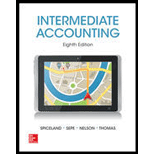
(1)
Nonmonetary Exchange
Exchange of non-monetary assets for another non-monetary asset is known as nonmonetary exchange.
Exchange has commercial substance:
If an exchange (Example: exchange of land for another non-monetary asset other than land) is likely to have a change in the future
Exchange lacks commercial substance:
If an exchange (Example: exchange of land for another land) is expected that it will not change the future cash flows, then such exchange is known as exchange lacks commercial substance. In this case, an exchange lacks commercial substance; therefore new non-monetary asset would be value at the book value of the old non-monetary asset.
To determine: The fair value of the new parcel land, which is received by Company T.
(2)
To prepare: The
(3)
To prepare: The journal entry, to record the exchange of old land for new parcel land, assumes that the exchange lacks commercial substance.
Want to see the full answer?
Check out a sample textbook solution
Chapter 10 Solutions
INTERMEDIATE ACCOUNTING
- Accounting?arrow_forwardFenton Manufacturing Inc. had a variable costing operating income of $128,400 in 2023. Ending inventory decreased during 2023 from 45,000 units to 40,000 units. During both 2022 and 2023, fixed manufacturing overhead was $1,080,000, and 135,000 units were produced. Determine the absorption costing operating income for 2023.arrow_forwardPlease provide the solution to this general accounting question with accurate financial calculations.arrow_forward
- Please provide the solution to this general accounting question using proper accounting principles.arrow_forwardCan you solve this general accounting question with the appropriate accounting analysis techniques?arrow_forwardPlease explain the solution to this general accounting problem with accurate explanations.arrow_forward
- I need assistance with this financial accounting question using appropriate principles.arrow_forwardWhat is variable cost per unit?arrow_forwardDunlop Systems applies manufacturing overhead to products based on standard machine-hours. The budgeted fixed manufacturing overhead cost for the most recent month was $28,800, and the actual fixed manufacturing overhead cost for the month was $29,320. The company based its original budget on 7,200 machine-hours. The standard hours allowed for the actual output of the month totaled 6,800 machine-hours. a. What was the overall fixed manufacturing overhead budget variance for the month? b. What was the fixed overhead rate? c. What was the volume variance?arrow_forward
- I need help with this general accounting problem using proper accounting guidelines.arrow_forwardI am looking for the correct answer to this general accounting question with appropriate explanations.arrow_forwardI need help finding the accurate solution to this general accounting problem with valid methods.arrow_forward

 AccountingAccountingISBN:9781337272094Author:WARREN, Carl S., Reeve, James M., Duchac, Jonathan E.Publisher:Cengage Learning,
AccountingAccountingISBN:9781337272094Author:WARREN, Carl S., Reeve, James M., Duchac, Jonathan E.Publisher:Cengage Learning, Accounting Information SystemsAccountingISBN:9781337619202Author:Hall, James A.Publisher:Cengage Learning,
Accounting Information SystemsAccountingISBN:9781337619202Author:Hall, James A.Publisher:Cengage Learning, Horngren's Cost Accounting: A Managerial Emphasis...AccountingISBN:9780134475585Author:Srikant M. Datar, Madhav V. RajanPublisher:PEARSON
Horngren's Cost Accounting: A Managerial Emphasis...AccountingISBN:9780134475585Author:Srikant M. Datar, Madhav V. RajanPublisher:PEARSON Intermediate AccountingAccountingISBN:9781259722660Author:J. David Spiceland, Mark W. Nelson, Wayne M ThomasPublisher:McGraw-Hill Education
Intermediate AccountingAccountingISBN:9781259722660Author:J. David Spiceland, Mark W. Nelson, Wayne M ThomasPublisher:McGraw-Hill Education Financial and Managerial AccountingAccountingISBN:9781259726705Author:John J Wild, Ken W. Shaw, Barbara Chiappetta Fundamental Accounting PrinciplesPublisher:McGraw-Hill Education
Financial and Managerial AccountingAccountingISBN:9781259726705Author:John J Wild, Ken W. Shaw, Barbara Chiappetta Fundamental Accounting PrinciplesPublisher:McGraw-Hill Education





